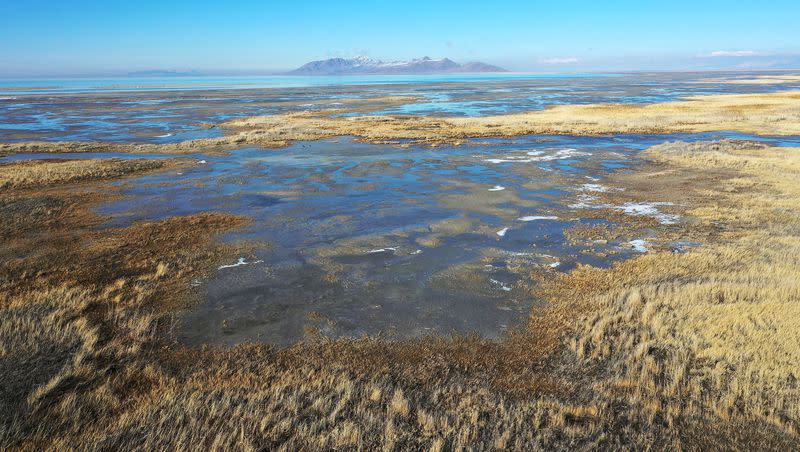Opinion: The church’s historic water donation for saving the Great Salt Lake is the ‘Utah Way’

Think of it as the Great Salt Lake bucket brigade. Every person, organization and entity that uses water lining up to make sure the Western hemisphere’s largest saline lake — worth $1.9 billion a year to the state’s economy and provider of a critical benefit to a large metropolitan area’s climate and snowpack — not just survives but thrives.
With a BYU study predicting the lake could dry up in five years without a massive influx of water ringing in the ears of all state residents, the situation requires all hands on deck.
To that end, it’s hard to overstate the size of the bucket or the value of the gift The Church of Jesus Christ of Latter-day Saints provided Wednesday when it agreed to donate more than 5,700 shares it holds in the North Point Consolidated Irrigation Company to the state. That’s the equivalent of more than 20,000 acre-feet every year, or the size of Little Dell Reservoir. It is 50 cubic feet per second. It’s more than 15,000 football fields of water a foot deep.
It is, in other words, a lot of water and the largest ever donated for the lake, and it will flow into the lake in perpetuity. The church, which owns this newspaper, had used the water for agricultural purposes.
This is a triumph of cooperation and partnerships. The donation is a result of collaborations among the church, the governor’s office, conservation groups and the Department of Natural Resources. The department will manage the donation in partnership with the Great Salt Lake Watershed Enhancement Trust.
In a DNR news release, Marcelle Shoop, who is both director of the saline lakes program for the National Audubon Society and executive director of the Great Salt Lake Watershed Enhancement Trust, emphasized the importance of organizations working together. “We are extremely appreciative of this commitment being made by the church, the efforts of DNR and the collaborative approach to addressing the water needs of the state,” she said.
The news release also said the donation “paves the way for future partnerships and will include new measurement infrastructure to better track water deliveries to the lake.”
Related
New analysis says Great Salt Lake can be saved, but not without great effort, and expense
Church makes largest-ever donation of water shares to benefit Great Salt Lake
This may be the most understated part of the announcement. It hints of ways to better monitor the health of the ailing lake, which has been sorely lacking. It also is a clarion call to others to collaborate to find ways to increase flows to the lake. It is a call to follow the “Utah way,” collaborating and cooperating in order to tackle big, important issues.
State lawmakers have dedicated about $1 billion over the past two years toward restoring the lake, which reached record low levels last year. But they have missed on other opportunities. A bill that would have banned the watering of lawns from Oct. 1 to April 25 each year failed recently because water districts objected to a provision that required the water saved to flow into the lake.
Politics and divergent interests can be difficult to maneuver. Partnerships, on the other hand, take effort to solidify but result in solutions more powerful than anything a government mandate could provide.
Utah has a reputation for crafting such solutions. This has been manifested in collaborative solutions to the intersection of rights regarding religious freedom and LGTBQ rights, in immigration law and in other ways.
Utahns also are used to gaining national attention for their volunteer spirit and their ability to respond to disasters. The state consistently ranks atop the nation for voluntarism. This is especially true when natural catastrophes hit.
Bucket brigades are best known as ways to fight fires. People form a long line, allowing buckets of water to travel quickly, person-by-person, from a water source to the fire.
In many real ways, the Great Salt Lake is on the verge of a disaster, the implications of which would be far greater than a fire.
Related
Opinion: The Great Salt Lake’s fate affects everyone in the state
Opinion: What Utah lawmakers did — and didn’t do — for the Great Salt Lake and controversial issues
“The Great Salt Lake and the ecosystem that depends on it are so important,” said Bishop W. Christopher Waddell, first counselor in the Presiding Bishopric of the church. “The church wants to be part of the solution because we all have a responsibility to care for and be good stewards of the natural resources that God has given to us. We invite others to join with us to help.”
That invitation ought to lead to a resounding response from everyone in the state. Despite near record snowfall this winter, Utahns must make water conservation a way of life.
The BYU study on the lake concluded, “we need farmers, counties, cities, businesses, churches, universities, and other organizations to do everything in their power to reduce outdoor water use.”
The church’s donation is an impressive example of leadership toward helping lake levels, but even small efforts can multiply to impressive results.
Given the consequences of losing the lake, there really is no other choice.

